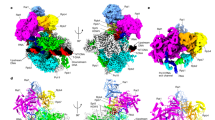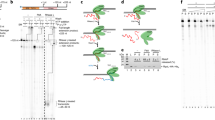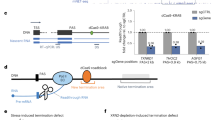Abstract
New evidence indicates that termination of transcription is an important regulatory step, closely related to transcriptional interference1 and even transcriptional initiation2. However, how this occurs is poorly understood. Recently, in vivo analysis of transcriptional termination for the human β-globin gene revealed a new phenomenon—co-transcriptional cleavage (CoTC)3. This primary cleavage event within β-globin pre-messenger RNA, downstream of the poly(A) site, is critical for efficient transcriptional termination by RNA polymerase II3. Here we show that the CoTC process in the human β-globin gene involves an RNA self-cleaving activity. We characterize the autocatalytic core of the CoTC ribozyme and show its functional role in efficient termination in vivo. The identified core CoTC is highly conserved in the 3′ flanking regions of other primate β-globin genes. Functionally, it resembles the 3′ processive, self-cleaving ribozymes described for the protein-encoding genes from the myxomycetes Didymium iridis and Physarum polycephalum, indicating evolutionary conservation of this molecular process. We predict that regulated autocatalytic cleavage elements within pre-mRNAs may be a general phenomenon and that functionally it may provide the entry point for exonucleases involved in mRNA maturation, turnover and, in particular, transcriptional termination.
This is a preview of subscription content, access via your institution
Access options
Subscribe to this journal
Receive 51 print issues and online access
$199.00 per year
only $3.90 per issue
Buy this article
- Purchase on Springer Link
- Instant access to full article PDF
Prices may be subject to local taxes which are calculated during checkout




Similar content being viewed by others
References
Greger, I. H., Aranda, A. & Proudfoot, N. J. Balancing transcriptional interference and initiation on the GAL7 promoter of Saccharomyces cerevisiae. Proc. Natl Acad. Sci. USA 97, 8415–8420 (2000)
Krishnamurthy, S., He, X., Reyes-Reyes, M., Moore, C. & Hampsey, M. Ssu72 is an RNA polymerase II CTD phosphatase. Mol. Cell 14, 387–394 (2004)
Dye, M. J. & Proudfoot, N. J. Multiple transcript cleavage precedes polymerase release in transcription by RNA polymerase II. Cell 105, 669–681 (2001)
Kwek, K. Y. et al. U1 snRNA associates with TFIIH and regulates transcriptional initiation. Nature Struct. Biol. 9, 800–805 (2002)
Lee, M. J. & Greenleaf, L. A. Modulation of RNA polymerase II elongation efficiency by C-terminal heptapeptide repeat domain kinase I. J. Biol. Chem. 272, 10990–10993 (1997)
Lilley, D. M. J. The origins of RNA catalysis in ribozymes. Trends Biochem. Sci. 28, 495–501 (2003)
Cech, T. R., Zaug, A. J. & Grabowski, P. J. In vitro splicing of the ribosomal RNA precursor of Tetrahymena: involvement of a guanosine nucleotide in the excision of the intervening sequence. Cell 27, 487–496 (1981)
Doherty, E. & Doudna, J. Ribozyme structures and mechanisms. Annu. Rev. Biochem. 69, 597–615 (2000)
Winkler, W. C., Nahvi, A., Roth, A., Collins, J. A. & Breaker, R. R. Control of gene expression by a natural metabolite-responsive ribozyme. Nature 428, 281–286 (2004)
Li, Y. & Breaker, R. R. Kinetics of RNA degradation by specific base catalysis of transesterification involving the 2′-hydroxyl group. J. Am. Chem. Soc. 121, 5364–5372 (1999)
Emilsson, G. M., Nakamura, S., Roth, A. & Breaker, R. R. Ribozyme speed limits. RNA 9, 907–918 (2003)
Zuker, M. Mfold web server for nucleic acid folding and hybridisation prediction. Nucleic Acids Res. 31, 3406–3415 (2003)
Winkler, W. C. & Breaker, R. R. Genetic control by metabolite-binding riboswitches. Chembiochem 4, 1024–1032 (2003)
Cech, T. R. The chemistry of self-splicing RNA and RNA enzymes. Science 236, 1532–1539 (1987)
Bass, B. L. & Cech, T. R. Specific interaction between the self-splicing RNA of Tetrahynema and its guanosine substrate: implications for biological catalysis by RNA. Nature 308, 820–826 (1984)
Stage, K. T. & Uhlenbeck, O. C. Hammerhead ribozyme kinetics. RNA 4, 875–889 (1998)
Down, T. A. & Hubbard, J. P. Computational detection and location of transcription start sites in mammalian genomic DNA. Genome Res. 12, 458–461 (2002)
Vader, A., Nielsen, H. & Johansen, S. In vivo expression of the nucleolar group I intron-encoded I-dirI homing endonuclease involves the removal of a spliceosomal intron. EMBO J. 18, 1003–1013 (1999)
Rocheleau, G. A. & Woodson, S. A. Requirements for self-splicing of a group I intron from Physarum polycephalum. Nucleic Acids Res. 22, 4315–4320 (1994)
Yonaha, M. & Proudfoot, N. J. Transcriptional termination and coupled polyadenylation in vitro. EMBO J. 19, 3770–3777 (2000)
Samarsky, D. A. et al. A small nucleolar RNA: ribozyme hybrid cleaves a nucleolar RNA target in vivo with near-perfect efficiency. Proc. Natl Acad. Sci. USA 96, 6609–6614 (1999)
Parker, R. & Song, H. The enzymes and control of eukaryotic mRNA turnover. Nature Struct. Mol. Biol. 11, 121–127 (2004)
Bousquet-Antonelli, C., Presutti, C. & Tollervey, D. Identification of a regulated pathway for nuclear pre-mRNA turnover. Cell 102, 765–775 (2000)
van Hoof, V. A. & Parker, R. Messenger RNA degradation: beginning at the end. Curr. Biol. 12, 285–287 (2002)
Chen, C. et al. AU binding proteins recruit the exosome to degrade ARE-containing mRNAs. Cell 107, 451–464 (2001)
West, S., Gromak, N. & Proudfoot, N. J. Human 5′ → 3′ exonuclease Xrn2 promotes transcription termination at co-transcriptional cleavage sites. Nature doi:10.1038/nature03035 (this issue)
Adams, S. E. et al. Synthesis of a gene for the HIV transactivator protein Tat by a novel single-stranded approach using gap repair. Nucleic Acids Res. 15, 4287–4287 (1988)
Tahiri-Alaoui, A. et al. High affinity nucleic acid aptamers for streptavidin incorporated into bi-specific capture ligands. Nucleic Acids Res. 30, 1–9 (2002)
Dye, M. J. & Proudfoot, N. J. Terminal exon definition occurs co-transcriptionally and promotes termination of RNA polymerase II. Mol. Cell 3, 371–378 (1999)
Ashe, H. L., Monks, J., Wijgerde, M., Fraser, P. & Proudfoot, N. J. Intergenic transcription and transinduction of the human β-globin locus. Genes Dev. 11, 2494–2509 (1997)
Acknowledgements
We thank T. Nilsen, J. Manley, S. Valadkhan, C. Smith and P. C. Branco for their critical comments and constructive support. This work was supported by grants to W.J. from BBSRC and Edward P. Abraham Research Fund, to N.J.P. from the Wellcome Trust and to A.A. from the Wellcome Trust Career Development Programme, Medical Research Council, Cancer Research UK, Edward P. Abraham Research Fund and Exeter College (Oxford).Authors' contributions A.T. is the lead author. A.T.-A. and S.W. are second authors, and contributed equally to this work. A.T.-A. and W.J. are responsible for the RNA secondary structure analysis. S.W. and N.J.P. are responsible for making the CoTC mutants and testing them by nuclear run-on analysis.
Author information
Authors and Affiliations
Corresponding author
Ethics declarations
Competing interests
The authors declare that they have no competing financial interests.
Supplementary information
Supplementary Figure Legends
Legends for Supplementary Figures 1–4. Stability of CoTC RNA. Analysis of the CoTC core secondary structure. Autocatalytic cleavage of the CoTC core and its GTP dependence. (DOC 26 kb)
Supplementary Figures
Supplementary Figures 1–4. Stability of CoTC RNA. Analysis of the CoTC core secondary structure. Autocatalytic cleavage of the CoTC core and its GTP dependence. (PDF 1840 kb)
Rights and permissions
About this article
Cite this article
Teixeira, A., Tahiri-Alaoui, A., West, S. et al. Autocatalytic RNA cleavage in the human β-globin pre-mRNA promotes transcription termination. Nature 432, 526–530 (2004). https://doi.org/10.1038/nature03032
Received:
Accepted:
Issue Date:
DOI: https://doi.org/10.1038/nature03032
This article is cited by
-
RNA motifs and combinatorial prediction of interactions, stability and localization of noncoding RNAs
Nature Structural & Molecular Biology (2018)
-
Solution structure and metal ion binding sites of the human CPEB3 ribozyme’s P4 domain
JBIC Journal of Biological Inorganic Chemistry (2014)
-
The novel tumor suppressor NOL7 post-transcriptionally regulates thrombospondin-1 expression
Oncogene (2013)
-
Unravelling the means to an end: RNA polymerase II transcription termination
Nature Reviews Molecular Cell Biology (2011)
-
Intronic hammerhead ribozymes are ultraconserved in the human genome
EMBO reports (2010)
Comments
By submitting a comment you agree to abide by our Terms and Community Guidelines. If you find something abusive or that does not comply with our terms or guidelines please flag it as inappropriate.



